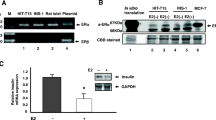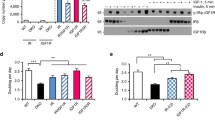Abstract
The mechanism(s) of insulin’s effects on growth hormone receptor (GHR) gene expression are poorly understood. Using rat hepatoma cells, we have previously shown that insulin treatment reduces GHR mRNA and protein in a time- and concentration-dependent manner, at least in part via down-regulation of GHR transcription. The present study determines whether the phosphatidylinositol-3 kinase (PI-3 kinase) and mitogen activated protein kinase kinase (MEK)/extracellular signal-regulated kinase (ERK) pathways are involved in mediating these effects of insulin. Inhibition of the PI-3 kinase pathway partially blocked insulin’s reduction of GHR mRNA, as did inhibition of the MEK/ERK pathway, resulting in higher GHR mRNA levels. Inhibition of both pathways was necessary to completely block insulin effects. Similar results were obtained for GHR protein. Collectively, these data suggest that insulin signaling via either the PI-3 kinase or MEK/ERK pathway may result in partial reduction of GHR gene expression, whereas signaling via both pathways may be required to achieve the full insulin effect.





Similar content being viewed by others
Abbreviations
- ERK:
-
Extracellular signal-regulated kinase
- GH:
-
Growth hormone
- GHR:
-
Growth hormone receptor
- MEK:
-
Mitogen activated protein kinase kinase
- PI-3 kinase:
-
Phosphatidylinositol-3 kinase
References
J.L. Messina, in Regulation of Gene Expression by Insulin, ed. by P. Cuatrecasas, S.J. Jacobs. Handbook of Experimental Pharmacology, vol 92: Insulin, (Springer-Verlag, New York, 1990), pp. 399-419
J.L. Messina, in Insulin as a Growth-Promoting Hormone, ed. by J.L. Kostyo. Handbook of Physiology, Section 7: The Endocrine System. Volume V: Hormonal Control of Growth, (Oxford University Press, New York, 1999), pp. 783-811
S. Ji, R. Guan, S.J. Frank, J.L. Messina, Insulin inhibits growth hormone signaling via the growth hormone receptor/JAK2/STAT5B pathway. J. Biol. Chem. 274, 13434–13442 (1999)
K.C. Leung, I.A. Rajkovic, E. Peters, I. Markus, J.J. Van Wyk, K.K.Y. Ho, Insulin-like growth factor I and insulin down-regulate growth hormone (GH) receptors in rat osteoblasts: evidence for a peripheral feedback loop regulating GH action. Endocrinology 137, 2694–2702 (1996)
R.K. Menon, D.A. Stephan, R.H. Rao, Z. Shen-Orr, L.S. Downs Jr., C.T. Roberts Jr., D. Leroith, M.A. Sperling, Tissue-specific regulation of the growth hormone receptor gene in streptozocin-induced diabetes in the rat. J. Endocrinol. 142, 453–462 (1994)
S. Niimi, T. Hayakawa, A. Tanaka, Hormonal regulation of growth hormone receptors in primary cultured rat hepatocytes. Endocrinology 127, 688–694 (1990)
C.C. Orlowski, G.T. Ooi, D.R. Brown, Y.W.H. Yang, L.Y.H. Tseng, M.M. Rechler, Insulin rapidly inhibits insulin-like growth factor-binding protein-1 gene expression in H4-II-E rat hepatoma cells. Mol. Endocrinol. 5, 1180–1187 (1991)
G.T. Ooi, F.J. Cohen, L.Y. Tseng, M.M. Rechler, Y.R. Boisclair, Growth hormone stimulates transcription of the gene encoding the acid-labile subunit (ALS) of the circulating insulin-like growth factor-binding protein complex and ALS promoter activity in rat liver. Mol. Endocrinol. 11, 997–1007 (1997)
S. Ji, S.J. Frank, J.L. Messina, Growth hormone-induced differential desensitization of STAT5, ERK, and Akt phosphorylation. J. Biol. Chem. 277, 28384–28393 (2002)
A.B. Keeton, M.O. Amsler, D.Y. Venable, J.L. Messina, Insulin signal transduction pathways and insulin-induced gene expression. J. Biol. Chem. 277, 48565–48573 (2002)
A.B. Keeton, K.D. Bortoff, J.L. Franklin, J.L. Messina, Blockade of rapid versus prolonged extracellularly regulated kinase 1/2 activation has differential effects on insulin-induced gene expression. Endocrinology 146, 2716–2725 (2005)
A.B. Keeton, K.D. Bortoff, W.L. Bennett, J.L. Franklin, D.Y. Venable, J.L. Messina, Insulin-regulated expression of Egr-1 and Krox20: dependence on ERK1/2 and interaction with p38 and PI3-kinase pathways. Endocrinology 144, 5402–5410 (2003)
J. Xu, A.B. Keeton, J.L. Franklin, X. Li, D.Y. Venable, S.J. Frank, J.L. Messina, Insulin enhances growth hormone induction of the MEK/ERK signaling pathway. J. Biol. Chem. 281, 982–992 (2006)
J. Xu, Z. Liu, T.L. Clemens, J.L. Messina, Insulin reverses growth hormone-induced homologous desensitization. J. Biol. Chem. 281, 21594–21606 (2006)
W.L. Bennett, S. Ji, J.L. Messina, Insulin regulation of growth hormone receptor gene expression Evidence for a transcriptional mechanism of down-regulation in rat hepatoma cells. Mol. Cell. Endocrinol. 274, 53–59 (2007)
R.S. Streeper, C.A. Svitek, S. Chapman, L.E. Greenbaum, R. Taub, R.M. O’Brien, A multicomponent insulin response sequence mediates a strong repression of mouse glucose-6-phosphatase gene transcription by insulin. J. Biol. Chem. 272, 11698–11701 (1997)
J.L. Messina, J. Hamlin, J. Larner, Effects of insulin alone on the accumulation of a specific mRNA in rat hepatoma cells. J. Biol. Chem. 260, 16418–16423 (1985)
D. Le Roith, Y. Zick, Recent advances in our understanding of insulin action and insulin resistance. Diabetes Care 24, 588–597 (2001)
M.F. White, The insulin signalling system and the IRS proteins. Diabetologia 40(Suppl), S2–S17 (1997)
J. Nakae, D. Accili, The mechanism of insulin action. J. Pediatr. Endocrinol. Metab. 12(Suppl 3), 721–731 (1999)
A. Virkamaki, K. Ueki, C.R. Kahn, Protein-protein interaction in insulin signaling and the molecular mechanisms of insulin resistance. J. Clin. Invest. 103, 931–943 (1999)
C. Taha, A. Klip, The insulin signaling pathway. J. Membr. Biol. 169, 1–12 (1999)
D.R. Lessi, C.P. Downes, The role of PI 3-kinase in insulin action. Biochim. Biophys. Acta. 1436, 151–164 (1998)
P.R. Shepherd, D.J. Withers, K. Siddle, Phosphoinositide 3-kinase: the key switch mechanism in insulin signalling. Biochem. J. 333, 471–490 (1998)
R.M. Denton, J.M. Tavare, Does mitogen-activated-protein kinase have a role in insulin action? The cases for and against. Eur. J. Biochem. 227, 597–611 (1995)
Y. Ma, P. Wang, J.F. Kuebler, I.H. Chaudry, J.L. Messina, Hemorrhage induces the rapid development of hepatic insulin resistance. Am. J. Physiol. Gastrointest. Liver Physiol. 284, G107–G115 (2003)
J.L. Messina, Insulin and dexamethasone regulation of a rat hepatoma messenger ribonucleic acid: insulin has a transcriptional and a posttranscriptional effect Endocrinology 124, 754–761 (1989)
J.L. Messina, Insulin’s regulation of c-fos gene transcription in hepatoma cells. J. Biol. Chem. 265, 11700–11705 (1990)
J. Xu, A.B. Keeton, L. Wu, J.L. Franklin, X. Cao, J.L. Messina, Gene 33 inhibits apoptosis of breast cancer cells and increases poly(ADP-ribose) polymerase expression. Breast Cancer Res. Treat. 91, 207–215 (2005)
S.P. Davies, H. Reddy, M. Caivano, P. Cohen, Specificity and mechanism of action of some commonly used protein kinase inhibitors. Biochem. J. 351, 95–105 (2000)
D.R. Alessi, A. Cuenda, P. Cohen, D.T. Dudley, A.R. Saltiel, PD 098059 is a specific inhibitor of the activation of mitogen-activated protein kinase kinase in vitro and in vivo. J. Biol. Chem. 270, 27489–27494 (1995)
Y. Zhang, J. Jiang, J.J. Kopchick, S.J. Frank, Disulfide linkage of growth hormone (GH) receptors (GHR) reflects GH-induced GHR dimerization. Association of JAK2 with the GHR is enhanced by receptor dimerization. J. Biol. Chem. 274, 33072–33084 (1999)
Acknowledgments
We would like to thank Drs. Stuart Frank, Yuchen Ma, Adam B. Keeton, LaWanda T. Holland, Jie Xu, and John Lee Franklin for their helpful and insightful discussions and suggestions. This work was supported by grants from the National Institutes of Health (DK40456 and DK62071), the DOD (W81XWH-0510387) and the Veterans Administration Merit Review to Joseph L. Messina.
Author information
Authors and Affiliations
Corresponding author
Rights and permissions
About this article
Cite this article
Bennett, W.L., Keeton, A.B., Ji, S. et al. Insulin regulation of growth hormone receptor gene expression: involvement of both the PI-3 kinase and MEK/ERK signaling pathways. Endocr 32, 219–226 (2007). https://doi.org/10.1007/s12020-007-9021-2
Received:
Accepted:
Published:
Issue Date:
DOI: https://doi.org/10.1007/s12020-007-9021-2




